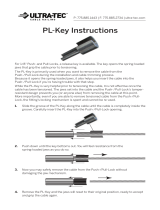
8
d. Store idle power tools out of the reach of children
and do not allow persons unfamiliar with the power
tool or these instructions to operate the power tool.
Power tools are dangerous in the hands of untrained
users.
e. Maintain power tools. Check for misalignment or
binding of moving parts, breakage of parts and any
other condition that may affect the power tools
operation. If damaged, have the power tool repaired
before use. Many accidents are caused by poorly
maintained power tools.
f. Keep cutting tools sharp and clean. Properly
maintained cutting tools with sharp cutting edges are
less likely to bind and are easier to control.
g. Use the power tool, accessories and tool bits etc. in
accordance with these instructions, taking into
account the working conditions and the work to be
performed. Use of the power tool for operations
different from those intended could result in a
hazardous situation.
5. Service
a. Have your power tool serviced by a qualified repair
person using only identical replacement parts. This
will make sure that the safety of the power tool is
maintained.
Additional safety instructions for the Alligator
TM
Lopper
Warning! Never use the tool above shoulder height. Always
position yourself out of the path of falling branches and
debris.
Warning! Do not use this tool to fell trees.
Keep all parts of your body and clothing away from the
saw chain at all times. Hold the tool in front of you and
be aware of the saw chain position especially when
cutting branches near the ground. Before you switch on
make sure the saw chain is not contacting anything.
Pre-plan a safe exit from falling branches and debris.
Ensure the exit route is clear of obstacles that would
prevent or hinder movement. Remember wet grass and
freshly cut bark is slippery.
Be aware of the direction that a branch may fall.
Consider all conditions that may affect the direction of
fall, including:
- The intended direction of fall.
- The natural lean of the branch.
- Any unusual heavy limb structure or decay.
- Surrounding trees and obstacles including overhead
lines.
- The wind speed and direction.
The safe distance between a branch and debris to be
felled and bystanders, buildings and other objects is at
least 2 1/2 times the length of the branch. Any
bystander, building or object within this distance is at
risk from being struck by the falling branch.
When cutting a limb that is under tension, be aware of
spring-back. When the tension in the wood fibres are
released the spring loaded limb may strike the operator
and/or throw the tool out of control.
Always wear suitable safety equipment such as non-
skid safety shoes, hard hat, goggles, ear protection and
gloves when operating the tool.
Ensure someone is nearby (at a safe distance) in case
of an accident.
Do not attempt to operate the tool when in a tree, on a
ladder or standing on any other unstable support.
Keep proper footing and balance at all times.
Hold the tool firmly with both hands when the motor is
running.
Keep handles dry, clean and free from oil and grease.
Greasy oily handles are slippery causing loss of control.
Do not let the moving chain contact any object at the tip
of the chain guide bar.
Keep your saw chain properly tensioned. Check tension
at regular intervals with the motor stopped and cord
disconnected.
Begin and continue cutting only with the chain moving at
full speed.
Watch for shifting branches or other forces that could
close a cut and pinch or fall into the chain.
Use extreme caution when re-entering a previous cut.
Engage spikes on lower jaw into wood and allow the
chain to reach full speed before proceeding with cut.
Use of this tool for operation different to those intended
could result in hazardous situations. Cut wood only.
Don't use this tool for purposes not intended - for
example - Don't use tool for cutting plastic, masonry or
non wood building materials.
If any debris gets caught with the guard or tool
discontinue use, disconnect the power cord and clear
debris.
Worn chains and chain guide bars should be replaced.
Only use replacement bars and chains specified by the
manufacturer.
Safety of others
This tool is not intended for use by persons (including
children) with reduced physical, sensory or mental
capabilities, or lack of experience and knowledge,
unless they have been given supervision or instruction
concerning the use of the appliance by a person
responsible for their safety.
















